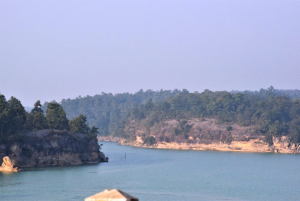A decade of resistance against mining activity, displacement, and deforestation met with defeat on April 6, when the Chhattisgarh government gave its final assent for felling of trees and commencement of mining activity in Hasdeo in the central Indian state of Chhattisgarh.
Back in 2011, the gram sabha (village assembly) of Ghatbarra village in the Hasdeo Arand forests passed a resolution opposing coal mining in the forests. Over ten years later, villagers in the area are determined to press on with their protests, calling on the government to halt the wanton destruction of India’s forest tracts.
The Hasdeo Arand region in Chhattisgarh’s northern district of Sarguja is one of the largest blocks of forests in central India. It extends over 170,000 hectares and its forests are home to over 350 species of animals.
Running through Hasdeo and its adjacent villages is the Hasdeo River – the lifeline of this under-attack forest region. While the region houses great biodiversity, the forests haven’t been designated as protected areas; such designation would have insulated them against exploitation of their natural resources.
The Hasdeo Arand Coalfield, which is spread over an area of 1,879.6 square kilometers, contains 23 coal blocks. Deforestation and mining approved by the government are estimated to displace over 700 people and threaten the freedom and livelihoods of tribal communities in the area. Some 20,000 trees are expected to be cut down.
The Parsa coal block has been assigned to the Rajasthan Rajya Vidyut Utpadan Nigam Ltd. while Adani Enterprises will be the developer and operator of the mines.
After the approval was granted on April 6, women of the region hugged the trees, recreating the sentiment of the Chipko movement, an ecological movement led by rural women in India’s Himalayan region of Uttarakhand. As in the Chipko Movement of the 1970s when women embraced trees to obstruct government loggers, the tribal women of Hasdeo are embracing the trees in a last resort effort to save the forest cover in the region.
Despite the government decision approving mining in the area, the protesters are keeping their struggle alive. They are camping in the forests to prevent the trees being cut. According to local activists, authorities want the protests to stop and are intimidating locals by registering complaints with the police.
On April 15, for instance, Anupam Dutta, believed to be an Adani employee, filed a complaint against 10 local activists, alleging that the protesters had engaged in fraud, rioting, unlawful assembly, criminal intimidation, etc.
Locals in Hasdeo told The Diplomat that they saw the felling of trees as a threat to their own lives.
“As the loggers moved towards the trees that had been marked for felling, we rushed to stop them,” said Girija, a Gond tribal woman who has been participating in the protests. According to locals, on April 25, trees were marked and numbered and cut down at night as protesters had engulfed the site during the day.
Hasdeo Arand contains more than a billion metric tons of coal reserves. Girija and other indigenous people see this as a curse as this is their home. The misfortune, they say, is because “everyone wants to eat up the land.”
India’s Council of Forestry Research and Education (ICFRE), a government body under the Ministry of Environment, recommended allowing coal mining in a part of the region but with adequate safeguards.
Earlier, ICFRE had deemed Hasdeo Arand area as a “no-go area;” it was to be left undisturbed, no mining would be legally possible. Nevertheless, the region’s rich mineral resources of power-grade coal were too lucrative for authorities and industrialists to leave unexploited. They simply mined the resources clandestinely.
Now that illegal business has been legalized. Extraction of resources is bound to grow.
To protest against the exploitation and monetization of their motherland, women in Surajpur district started a tree-hugging campaign on the morning of April 26, to stop the felling of trees for land clearance ahead of mineral extraction in the area. They are determined to continue with their protest against the deforestation and mining in the area.
They are not the only ones to be adversely affected by the mining activity.
The mines, and a 75-km-long rail line for transportation of coal and workers, are expected to impact the elephant population and hinder migration routes running through the forest. Incidents of human-elephant conflict have grown as the government sells their habitat to businesses.
In 2012, a year after the government had given permission for mining of the Parsa (East) and Kete Basan (PEKB) coal block, local communities formed a collective, the Hasdeo Aranya Bachao Sangarsh Samiti (HABSS), to protect and conserve the ecosystem of Hasdeo Arand and oppose the expansion of mining. The HABSS mobilized villagers across Hasdeo to raise their voices against mining in the area.
Mining of the PEKB block gave rise to a host of problems for the local people. Those displaced recall that they were pushed to the peripheries of the region. They were made to shift to accommodation that was small and without electricity or water. Many of the people who stayed in these houses reportedly moved out soon after as the facilities were poor.
India is facing a particularly brutal summer this year. As a heat wave sweeps the country, the need for electricity to run fans and air conditioners has surged. The need for coal has increased to unprecedented levels. This hunger for coal will be satiated by accelerating coal extraction. This means more deforestation, which will cause catastrophic damage to environmental ecosystems.
During the COP26 climate change summit in Glasgow in November 2021, Indian Prime Minister Narendra Modi pledged to cut down the country’s overall projected carbon emission by 1 billion tons by 2030, reduce the carbon intensity of the nation’s economy by around 45 percent by the end of the decade, and achieve net-zero carbon emissions by 2070.
At home, his government seems to be speeding up processes to cut down forests for coal mines.

































